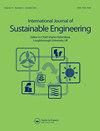Thermal behavior of diesel, honge oil methyl ester and ITS B-20 blend in atmospheric air and oxygen
IF 3.6
Q3 GREEN & SUSTAINABLE SCIENCE & TECHNOLOGY
International Journal of Sustainable Engineering
Pub Date : 2022-10-27
DOI:10.1080/19397038.2022.2131931
引用次数: 0
Abstract
ABSTRACT Thermal behavior of honge oil methyl ester (HOME) and its B-20 blend (20% HOME and 80% diesel) is examined by performing calorimetric experiments at 10°C/min heating rate in atmospheric air and oxygen medium. Thermogravitometry (TG) curves indicate two phases of decomposition for diesel and three phases for biofuel. Combustion reaction favors in oxidative atmosphere causing reduction in fuel preparation stage and increase in premixed burning phase reducing peak temperature of combustion and increasing enthalpy with high heat release rate. B-20 blend performance is similar to diesel with combustion index and intensity of combustion and is thermally stable with high offset temperature confirming more combustion duration. Blend of diesel lowers activation energy in initial stage of combustion process, whereas reverse trend is observed in final stage. Ignition index (Di) in air for diesel, HOME, and its B-20 blend is reduced by 70.11%, 34.92% and 42.80% respectively. Burnout index (Db) in air for diesel and B-20 blend reduced by 72% and 61% respectively whereas it increased by 28.5% for HOME. Combustion index (S) is more in air for HOME and its blend. Improved intensity of combustion is observed for diesel and B-20 blend in oxygen whereas reverse trend is observed for HOME.柴油、红格油甲酯和ITS B-20在大气和氧气中的热行为
摘要通过在大气和氧气介质中以10°C/min的加热速率进行量热实验,研究了红油甲酯(HOME)及其B-20共混物(20%HOME和80%柴油)的热行为。热重计(TG)曲线表示柴油的两个分解阶段和生物燃料的三个阶段。燃烧反应有利于氧化气氛中的燃烧,导致燃料制备阶段的减少和预混燃烧阶段的增加,降低了燃烧的峰值温度,并随着高热释放率而增加了焓。B-20混合物的性能在燃烧指数和燃烧强度方面与柴油相似,并且在高偏移温度下热稳定,从而确认了更长的燃烧持续时间。在燃烧过程的初始阶段,柴油的混合降低了活化能,而在燃烧的最后阶段则出现了相反的趋势。柴油、HOME及其B-20混合物在空气中的着火指数(Di)分别降低了70.11%、34.92%和42.80%。柴油和B-20混合物在空气中的燃尽指数(Db)分别降低了72%和61%,而HOME则增加了28.5%。HOME及其混合物在空气中的燃烧指数(S)更高。在氧气中观察到柴油和B-20混合物的燃烧强度提高,而在HOME中观察到相反的趋势。
本文章由计算机程序翻译,如有差异,请以英文原文为准。
求助全文
约1分钟内获得全文
求助全文
来源期刊

International Journal of Sustainable Engineering
GREEN & SUSTAINABLE SCIENCE & TECHNOLOGY-
CiteScore
7.70
自引率
0.00%
发文量
19
 求助内容:
求助内容: 应助结果提醒方式:
应助结果提醒方式:


